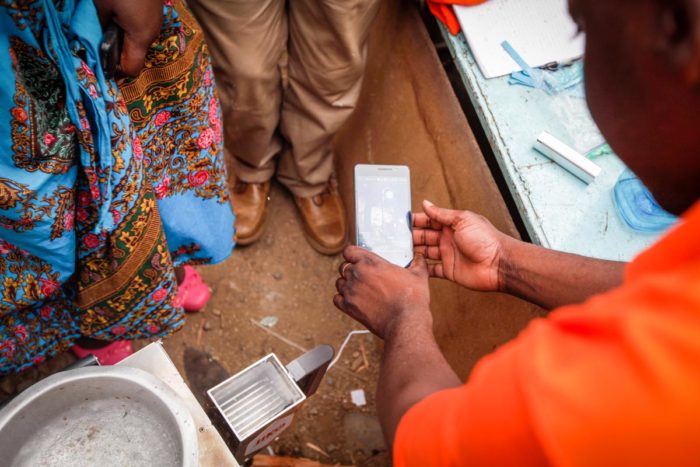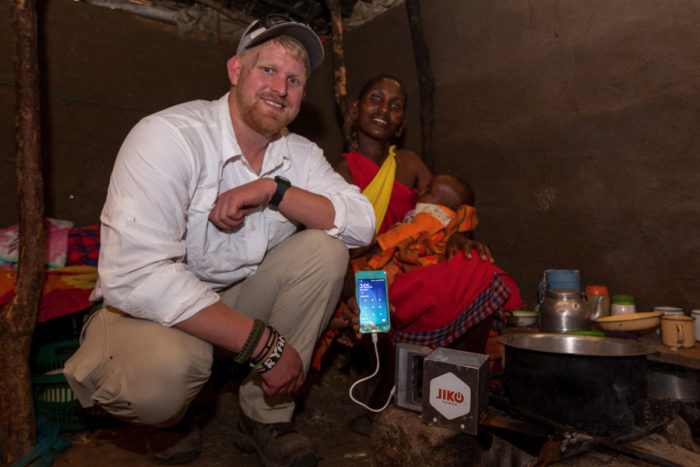
If the potential success of a new product can be measured by how many people stop and stare at it, the “JikoPower Spark” is a winner.
I’m sitting at Matt’s in the Market right above Pike Place trying to interview Ryan Ahearn, founder of JikoPower, the company that makes the device, which charges phones using excess heat generated from fire.
But our conversation suffers steady interruptions from curious passers-by.
There’s something about the Mad Max-looking metal cup with a long copper prong and industrial “JikoPower” logo that grabs people’s attention.
“Wait, you’re telling me if I have my little gas burner that I use to boil water for my dehydrated food, I can charge my phone?” marvels our waiter, wide-eyed, while filling our water glasses.
It’s the same astonished reaction everywhere, says Ahearn, whether you’re in Seattle or Kenya.
80 percent of Kenyans have phones, while only 20 percent have electricity. This means they often travel long distances to pay to charge their phones.
Last summer, Ahearn traveled with his team to East Africa to test the Spark in settings where people have phones but no electricity. He says 80 percent of Kenyans have phones, while only 20 percent have electricity. This means they often travel long distances to pay to charge their phones — phones that are used for essential daily tasks, like online banking, money transfers and weather reports for farmers.
He hopes the Spark — which uses material that converts heat into electricity by harnessing energy created through temperature differentials — can help change that for Kenya and for the hundreds of millions of people globally who have phones but no electricity.
Spark kits can also include a chargeable light bulb and portable power bank for other electrical needs.
“We had crowds shoulder to shoulder in this market in Kisumu (in Kenya),” recalls Ahearn of testing his product. “There were shops all over, and they were talking about us; everyone was abuzz about what we were doing.”
That same buzz is now spreading throughout the restaurant back in Seattle. And by the time we’ve pushed our coffees aside to make room for a little hot plate (brought by Ahearn), multiple people, including the chef, have gathered around our table to see the demonstration.
We all lean in as Ahearn fills the spark’s metal cup with water, places the attached copper prong on the stove and plugs a smartphone into a USB port nestled in the cup’s handle. We collectively gasp when the black screen lights up after a few moments.
Ahearn still remembers the magic of the first time he saw the Spark work himself.

During spring break of 2015, he, along with a team of fellow University of Washington engineering students working out of a garage, finally got a flip phone to charge off their prototype.
“Even after everything, I remember that moment,” he says smiling.
That technology won them $20,000 in the UW’s “Environmental Innovation Challenge.” From there they went on to win a total of almost $90,000 in prize money at various technology competitions. Those funds were used to apply for patents, finalize design, perfect the prototype, run the East Africa pilot and ultimately start JikoPower Inc.
On the day I met with Ahearn and Jiko Vice President Marene Wiley, they were in the final hours of an online fundraising campaign in which they hoped to collect $50,000 more, allowing them to “hit go” on manufacturing.
And while the primary goal of Jiko is to serve off-the-grid communities in the developing world, it’s clear this technology has lots of stateside applications as well, from backpacking to disaster-preparedness.
Ahearn says if they’re successful with this product they hope to expand into generators and other related items. In five years, he’d like for a million people to have access to the technology.
But there are still some kinks to work out, like finding distribution partners in Africa and identifying the perfect price point for multiple markets.
“We’re figuring out what we can make it for, and we’re figuring out what people are going to pay,” says Ahearn. “We’re going to find the spot where we can have a successful business and people will buy it.”
Based on the reactions I saw, and an online campaign that went $2,500 over goal a few days ago, they’re right on target.

